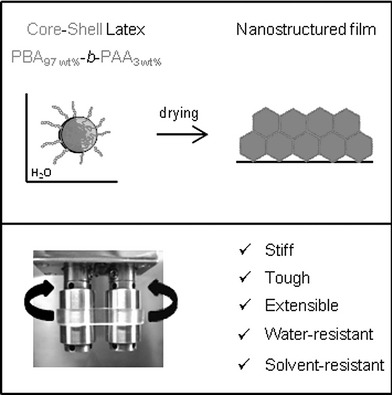Soft Nanostructured Films with an Ultra-Low Volume Fraction of Percolating Hard Phase
In this study, aqueous emulsion polymerization of n-butyl acrylate is performed in batch conditions without surfactants using a poly(acrylic acid)-trithiocarbonate macro-RAFT agent to control the polymerization and to stabilize the emulsion.

According to the polymerization-induced self-assembly (PISA) approach, well-defined amphiphilic PAA-b-PBA diblock copolymers form and self-assemble during synthesis to yield highly stable core-shell particles with an extremely thin hard PAA shell. For the first time, we report here the specific properties of films obtained from these particular latexes. After drying the aqueous dispersion, tough and transparent films are obtained. Although the films are not chemically cross-linked, they do not dissolve in good solvents for PBA. Moreover, they remain transparent even after immersion in water. Rheology shows that the films are both stiff and ductile, thanks to the nanostructured but very low volume fraction (less than 3 wt%) of PAA forming a percolating network in the soft PBA. Compared with conventional core-shell-based films, this approach affords for the first time a route to a thin percolating honeycomb nanostructure with a sharp and strong interface between the two phases. The versatility of the synthetic procedure opens perspectives for a large range of functional materials.
Macromol. Rapid Commun., 34: 1524–1529

